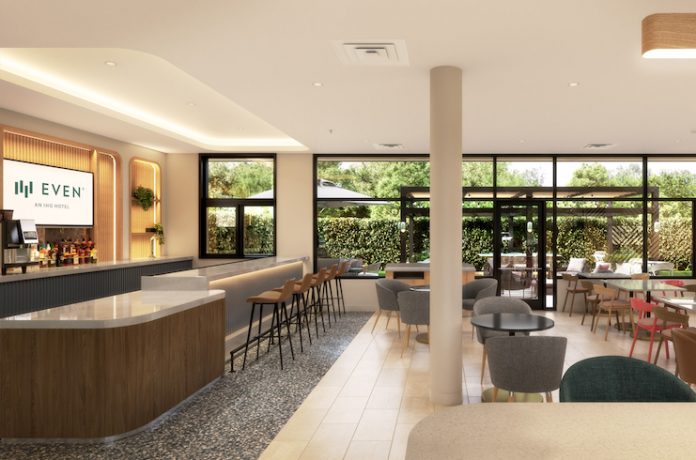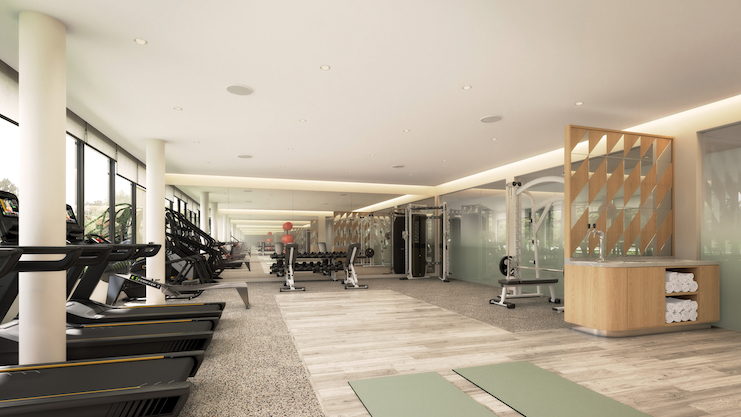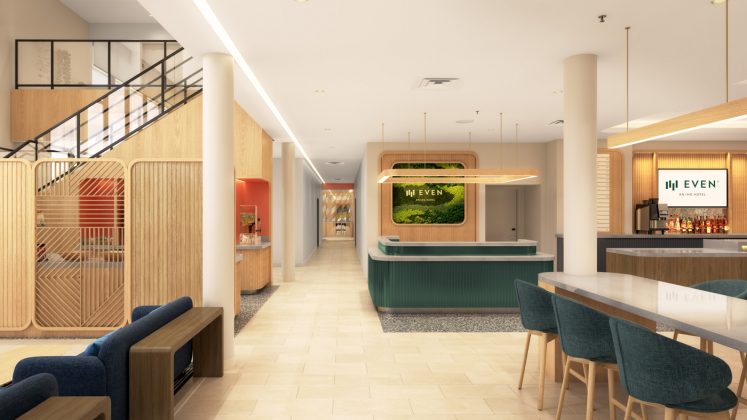
While COVID-19 cases have greatly diminished, on-the-road health and wellness remains prominent in the era of the pandemic. More travelers are aware of the importance of maintaining a healthy immune system, bolstered by regular physical exercise, good nutrition, a sound sleep, and other advisable practices. “The focus on health has risen significantly compared to what it was two years back,” confirms Harish Goyal, CEO and managing director, Veria Lifestyle, Inc., and developer of YO1 Health Resort, located in the Catskills of Upstate New York. “During COVID, we sat at home and reflected, we saw people dying, we got vaccinations, etc. That was a good time for all of us to understand how important health is. Everything else is important. But health is also important.”
As a result, many guests now have an elevated expectation that hoteliers will help them maintain their wellness regimens, via the latest fitness equipment, exercise programs, property design features, nutritional offerings, and more. A primary goal of wellness programs is stress reduction, which supports the immune system. “Finding the proper way to combat stress by practicing stress reduction fitness is critical to one’s overall well-being,” says Vincent Celano, founder and principal of Celano Design Studio Co., which was instrumental in designing the new prototype for EVEN Hotels, IHG Hotels & Resorts’ upscale wellness brand.
Wellness is the next frontier in the evolution of the guest experience, Celano feels, and a viable selling point for hoteliers because the demand is high. Marsha Ray, vice president of operations, Aimbridge Full Service Division, Aimbridge Hospitality, confirms, “Spa and healthy dining and beverage options have been very profitable in today’s market.” In addition, “many of the [wellness] activities and class-based offerings are included in resort and destination fees, which brings value to the fees and produces return.” To maximize the appeal of wellness offerings, hoteliers should pave the way for guests to take advantage of them. Thus, a key objective of the EVEN prototype design is to make it as convenient as possible for guests to continue the wellness lifestyles they pursue at home. “As we start traveling more, making a fitness lifestyle experience more accessible to hotel guests was the overarching idea for the design,” Celano explains.
Elements that make for a comfortable wellness experience at EVEN Hotels include complimentary infused water and nightly tea service in the lobby, complimentary on-demand digital fitness content, and a free daily laundry service for workout gear.
Reinventing In-Room Fitness
Naturally, the most accessible fitness opportunities are within the guestrooms themselves, where guests can adjust the temperature, lighting, TV programming, etc., to complement their workout as they wish. And here is where the room for improvement lies, Celano feels. His team aimed to create “approachable in-room fitness” for the EVEN Hotels prototype. “Starting a workout is often the hardest part, so creating an experience that is not intimidating and more inviting was the goal,” he says. “Most fitness experiences are rugged, institutional, and sometimes clinical in their feel. We focused on making sure the design was layered into the overall guestroom experience and not overpowering. We don’t want guests who aren’t really into fitness to be either intimidated by it or feel bad about not engaging with [the equipment].”
Toward achieving this aim, the new prototype replaces a large training pole (anchored to the floor, ceiling, and wall) with training hooks built into a wall near the window. This reconfigured fitness feature (offered in 30 percent to 40 percent of the rooms) is just one example of how the rooms are designed not to “push” exercise on guests. Indeed, wellness is also about relaxation, and so the room not only offers “a premium and easy-to-use fitness program, but also a place to unwind and relax,” Celano says. “The spa-like bathroom with soothing color palette and materials allows guests to refresh after a workout, to get the day started, or to wind down for the day. The bed area uses indirect light and a cocoon-style headboard to create an inviting and cozy place to recharge.” Materials and colors not only play into guestroom aesthetics, but they are also relevant to relaxation—a wellness connection that is sometimes overlooked. “White oak was used throughout the guestroom in both architectural elements and the furniture to create a natural and warm feel,” Celano describes. At YO1, “the [color] theme of the building itself is white, which is the color of peace,” Goyal notes. Lighting can also promote a sense of well-being. Celano explains how the EVEN Hotels guestroom prototype strategically used that element: “The lighting design was key to give the room both an energizing feel for working out and getting the day started, yet can transition to a calm, indirect light to unwind at the end of the day. Lighter materials like light gray wood flooring, textured striped-gray area rugs and warm white walls were used as the main finishes in the space to help this transition and pick up the light.” Thus, by putting thought into the in-room wellness experience, hoteliers can go a long way toward recreating the comfort level of the at-home wellness experience, which many people grew accustomed to during the pandemic.
Simple Wellness Enhancers
Many hotels that are not “wellness branded” still seek to offer guests more in that area, while keeping the investment reasonable. Fortunately, there are several simple wellness offerings that can be affordably introduced. “The most easily incorporated and cost-effective wellness amenities have little to no cost, depending on how the programming is structured,” says Ray. “Those options may include yoga, meditation, creative journaling, stargazing, sound healing, chakra classes, and other similar activities. We also offer a more premium version of some of these activities for people who are interested in making that additional personal investment.”
“The most easily incorporated and cost-effective wellness amenities have little to no cost, depending on how the programming is structured.” Marsha Ray, Vice President of Operations, Aimbridge Full Service Division
On the F&B side, juice bars are easy to incorporate and tend to be quite popular. “We have a juice bar that sells cold-pressed organic juices. We make around eight types, most of which have a purpose, such cleansing the system,” says Goyal. Hoteliers can also offer more light, healthy fare on their menus, which supports energy and concentration. Conference centers have long focused on that type of cuisine, given that their meeting attendees require mental clarity. As a health retreat, YO1 focuses entirely on plant-based foods. “Food is an integral part of curing the body,” says Goyal. “We offer only vegetarian, vegan, and gluten-free options; we don’t offer any meat. So that itself lightens up the weight on the body because now the system is not working very hard to decompose the meat, but only the plants and vegetables, which are easier to digest. So, by the time a guest consumes three meals with us, their body lightens up and they stop bloating. They feel well, sleep well, and wake up well in the morning.”
While a hotel can’t restrict its menu to the kind of cuisine Goyal describes, offering more inviting dishes of that type (and perhaps branding them as such) can encourage guests to opt for lighter fare and ultimately feel better during their stay. For example, the EVEN Kitchen & Bar restaurant showcases healthy cuisine, but also offers items for guests who see travel as a time to indulge. Another simple means of enhancing the sense of well-being is to optimize the lighting in areas that guests frequent, beyond the guestroom. “When a space doesn’t feel good, it’s oftentimes because of the lighting,” Celano advises. “So, if the operations the team is replacing lighting, be mindful of the original lighting design and try to maintain that.” Celano, whose team designs lighting in house, adds that 2700 bulbs produce the “warmer” lighting that creates a more comforting atmosphere, as opposed to the kind of lighting one experiences in a doctor’s office, for example. Natural light, if it’s well controlled and thoughtfully incorporated via property design, is also conducive to a sense of well-being.
The Investment Decision
Beyond simple and cost-effective wellness enhancers, hoteliers can of course make larger investments in gym, spa, and wellness programming. Whether to do so depends on the property’s branding and market. “The investment we make in wellness programming varies based on the market, type of hotel, brand, and other factors,” Ray says. “In some of our resort environments, such as the Sedona and Lake Tahoe markets, there is a guest expectation for wellness-driven initiatives. More and more customers look to hotels and resorts that offer a ‘menu’ of activities, which is the new version of all-inclusive and often table stakes for the active traveler. With growing average daily rates in many leisure markets, guests are shopping for value adds, structured programming, and a variety of initiatives for private and group travel, mind and body, and indoor and outdoor—it all just depends on the location and the specific hotel.”
And given the rising appeal of wellness offerings, they are certainly worth promoting. “We promote online on as many channels as possible, namely our website and social media, and we use notice boards throughout the properties,” says Ray. “We’re also exploring a Kipsu guest messaging program to notify in-house guests about our offerings and activities.”
The more guests who partake in those activities, the more “word of mouth” promotion they’ll receive among health-minded travelers.
EVEN Hotels Guestroom Fitness Equipment
Studio access Rooms will have a light touch on fitness:
- Yoga Mat
- Wellness and fitness video access on in-room TV
Deluxe Rooms will have a dedicated fitness zone with a range of accessories:
- Yoga Mat
- Yoga Blocks
- Resistance Bands
- Foam Roller
- Suspension Trainer
- Wellness and fitness video access on in-room TV
Premium Rooms will have a more spacious and upgraded fitness package:
- Yoga Mat
- Yoga Blocks
- Resistance Bands
- Foam Roller
- Suspension Trainer
- Peloton Bike
- Peleton Weights
- Wellness and fitness video access on in-room TV
HOTEL POOLS: Increasing Accessibility
All guests should be able to enjoy the wellness benefits of this amenity
Hotel pools serve as a recreational amenity while enabling health and wellness activities like swimming and various forms of aquatic therapy. However, “wellness” is broad category that can include simply relaxing at the pool as a means of stress management. Thus, wellness-minded hoteliers do well to maximize the access for swimmers and non-swimmers, including guests with disabilities.
“Accessible travel continues to be a burgeoning topic in the industry,” says Keith Chlapaty, founder/president of Unit Ten, LLC, producer of the EdgeMate Pool Chair. “There are now access points that are mandated by law at hotel swimming pools. Poolside lifts [which lower guests in wheelchairs into the pool] are probably the easiest way to get compliance. But in the case of newly built and renovated pool areas, you see zero-depth entry [allowing guests to enter the water via a gentle slope] more often as a way for everybody to enjoy what is probably the crown jewel amenity of most hotels.” Removing excessive poolside furniture also helps those with disabilities access the pool, and toward that end, in-pool chairs help to keep the area uncluttered. Such chairs are advantageous for those guests once they’re in the pool, affording them an easy place to decompress, socialize, and derive the accompanying mental health benefits. In addition, “the person who is partaking in water aerobics or turning laps will have a place to take a break without exiting the pool,” Chlapaty points out. “So, in-pool chairs check a lot of boxes within the realm of wellness.”















